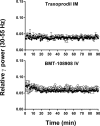The qEEG Signature of Selective NMDA NR2B Negative Allosteric Modulators; A Potential Translational Biomarker for Drug Development
- PMID: 27035340
- PMCID: PMC4817977
- DOI: 10.1371/journal.pone.0152729
The qEEG Signature of Selective NMDA NR2B Negative Allosteric Modulators; A Potential Translational Biomarker for Drug Development
Abstract
The antidepressant activity of the N-methyl-D-aspartate (NMDA) receptor channel blocker, ketamine, has led to the investigation of negative allosteric modulators (NAMs) selective for the NR2B receptor subtype. The clinical development of NR2B NAMs would benefit from a translational pharmacodynamic biomarker that demonstrates brain penetration and functional inhibition of NR2B receptors in preclinical species and humans. Quantitative electroencephalography (qEEG) is a translational measure that can be used to demonstrate pharmacodynamic effects across species. NMDA receptor channel blockers, such as ketamine and phencyclidine, increase the EEG gamma power band, which has been used as a pharmacodynamic biomarker in the development of NMDA receptor antagonists. However, detailed qEEG studies with ketamine or NR2B NAMs are lacking in nonhuman primates. The aim of the present study was to determine the effects on the qEEG power spectra of the NR2B NAMs traxoprodil (CP-101,606) and BMT-108908 in nonhuman primates, and to compare them to the NMDA receptor channel blockers, ketamine and lanicemine. Cynomolgus monkeys were surgically implanted with EEG radio-telemetry transmitters, and qEEG was measured after vehicle or drug administration. The relative power for a number of frequency bands was determined. Ketamine and lanicemine increased relative gamma power, whereas the NR2B NAMs traxoprodil and BMT-108908 had no effect. Robust decreases in beta power were elicited by ketamine, traxoprodil and BMT-108908; and these agents also produced decreases in alpha power and increases in delta power at the doses tested. These results suggest that measurement of power spectra in the beta and delta bands may represent a translational pharmacodynamic biomarker to demonstrate functional effects of NR2B NAMs. The results of these studies may help guide the selection of qEEG measures that can be incorporated into early clinical evaluation of NR2B NAMs in healthy humans.
Conflict of interest statement
Figures







References
-
- Association WAP. American Psychiatric Association: Diagnostic and Statistical Manual of Mental Disorders. 2000;Text Revision. 4th ed.
-
- Trivedi MH, Rush AJ, Wisniewski SR, Nierenberg AA, Warden D, Ritz L, et al. Evaluation of outcomes with citalopram for depression using measurement-based care in STAR*D: implications for clinical practice. Am J Psychiatry. 2006;163(1):28–40. - PubMed
-
- Berman RM, Cappiello A, Anand A, Oren DA, Heninger GR, Charney DS, et al. Antidepressant effects of ketamine in depressed patients. Biol Psychiatry. 2000;47(4):351–4. - PubMed
Publication types
MeSH terms
Substances
LinkOut - more resources
Full Text Sources
Other Literature Sources
Miscellaneous

